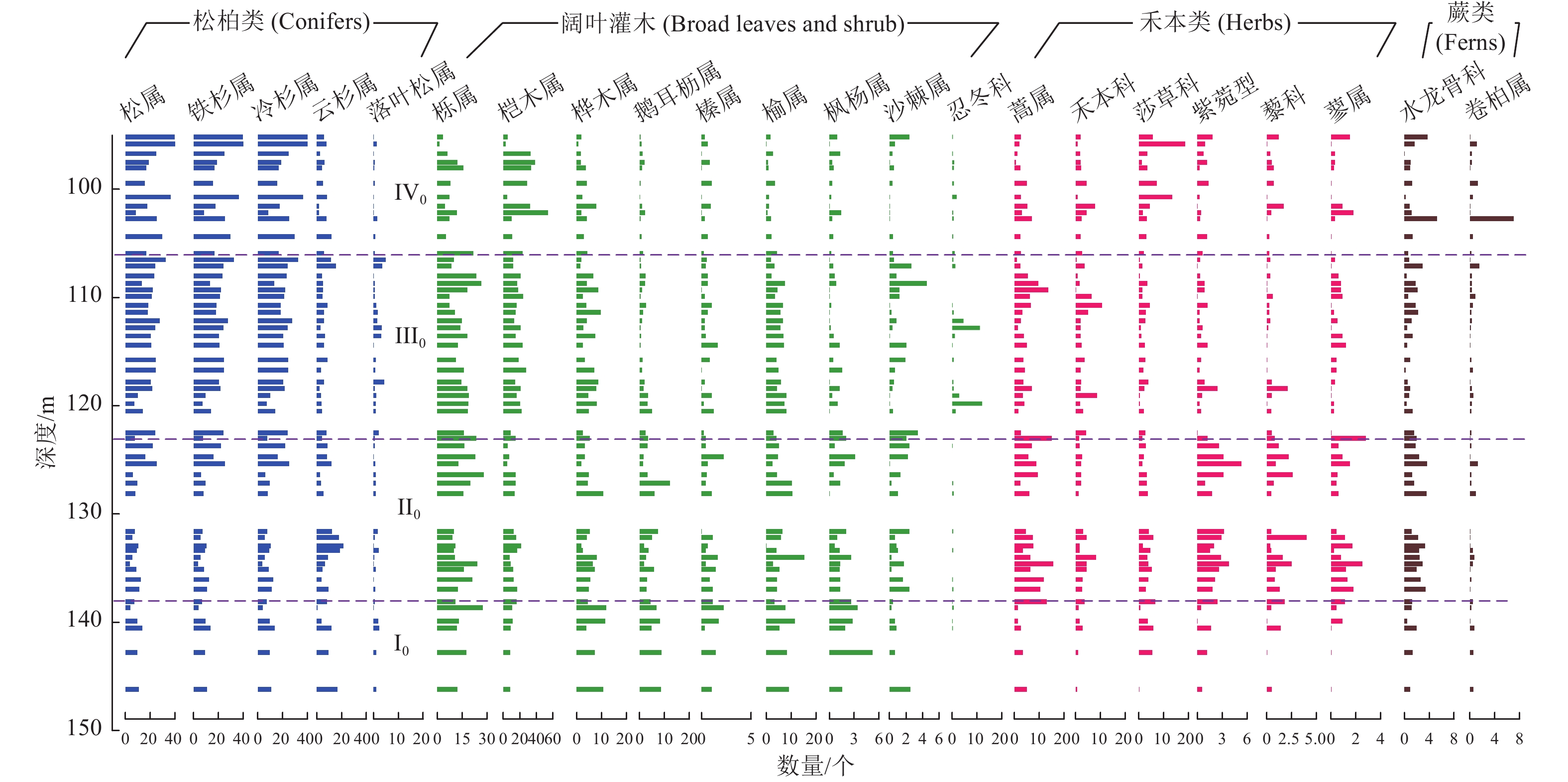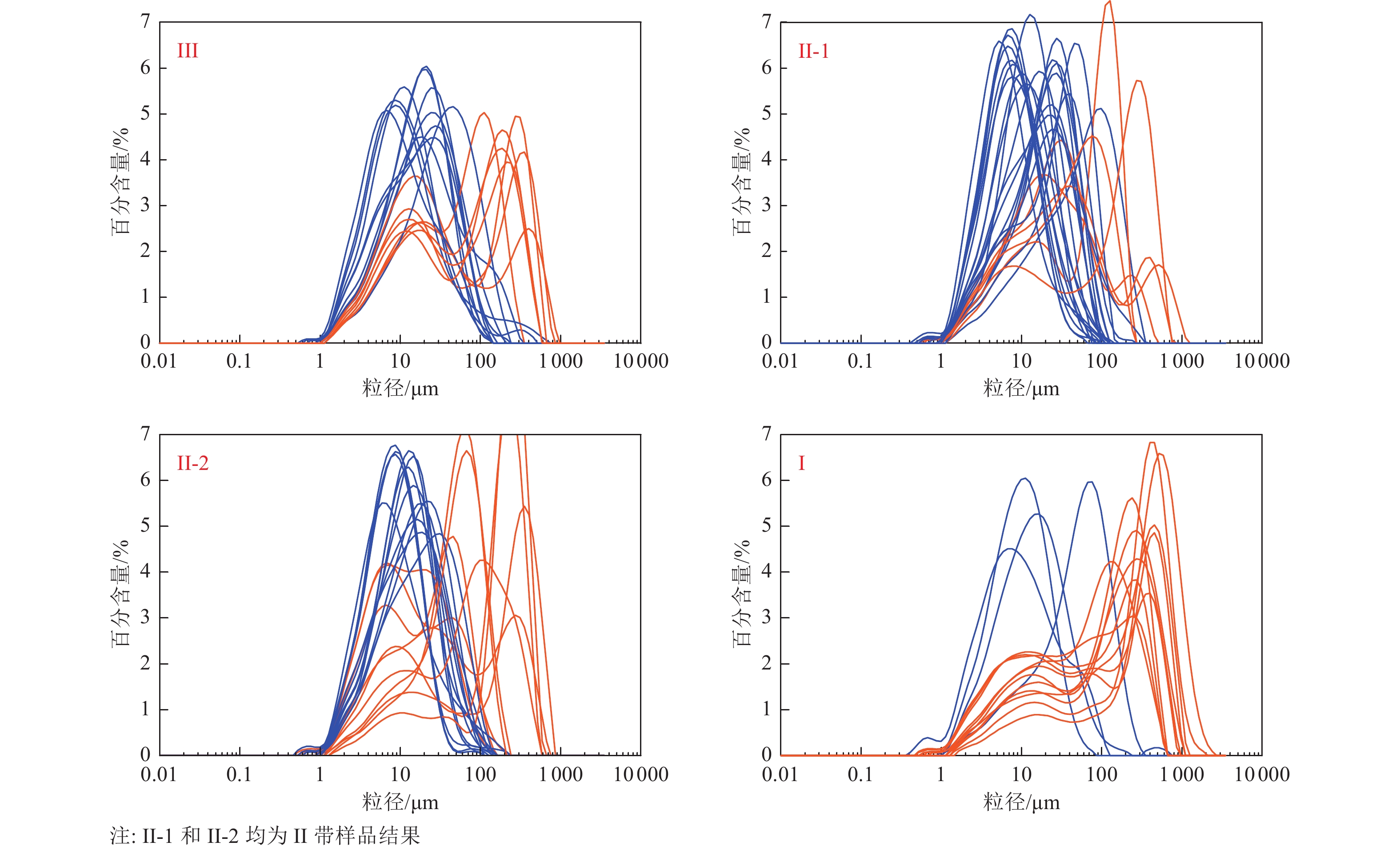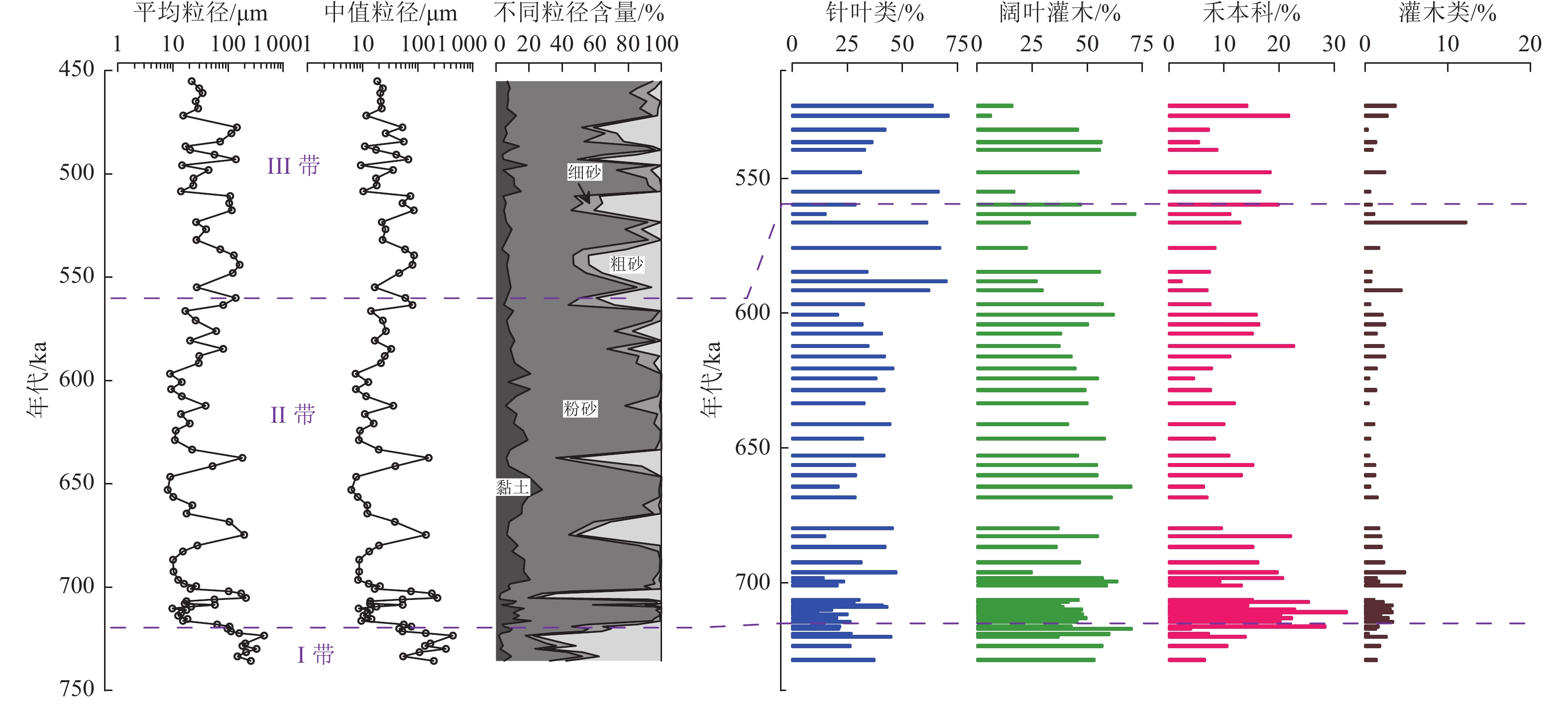Sedimentary Environment and Paleoenvironment Evolution of Early Middle Pleistocene Stage in Mianning Area
-
摘要: 昔格达组地层是我国西南地区晚新生代典型的沉积地层之一,但针对其沉积环境和古环境的研究记录较少。为此以冕宁县城西北方向钻孔揭示的昔格达组沉积物为研究对象,通过沉积物年代、粒度和孢粉测试分析,结合沉积序列、岩性岩相、沉积构造特征等,可知736~719 ka期间沉积物以滨湖亚相的沉积环境为主,植被分布存在显著的垂直地带性,气候整体温暖湿润;719~563 ka期间沉积物以深湖-滨湖亚相的沉积环境为主,此阶段针叶类植被花粉含量增加,禾本花粉含量稍有下降,气候较上一阶段变冷干;563~455 ka期间沉积物以半深湖-浅湖亚相沉积环境为主,此阶段针叶类植被花粉含量增高,阔叶类植被花粉含量稍有减少,指示该时期古环境较为冷湿。Abstract: The Xigeda Formation is a typical late Cenozoic sedimentary formation in southwest China, but there are few records of its sedimentary environment and paleoenvironment. This research mainly focuses on the sediments of the Xigeda Formation revealed by drilling in the northwest direction of Mianning county. Through the analysis of sediment chronology, particle size and palyore, the comprehensive sedimentary sequence, lithology and sedimentary structure characteristics, results show that the sedimentary environment of Binhu subfacies was dominant during 736~719 ka, and the vegetation distribution showed significant vertical zonality, and the overall climate was warm and humid; during 719~563 ka, the sedimentary environment of deep lake-Binhu subfacies increased the content of conifer, decreased the content of grass, and the climate became cold and dry; during 563~455 ka, the sedimentary environment was dominated by semi-deep lacustrine and shallow lacustrine subfacies. The content of coniferous vegetation increased while that of broad-leaved vegetation decreased slightly, indicating that the paleoenvironment in this period was relatively cold and wet.
-
Key words:
- Mianning /
- Xigeda formation /
- Sediments /
- Grain-size /
- Pollen
-
表 1 ZK1钻孔昔格达组岩性描述与地层层位序列
Table 1. Lithologic description of Xigeda Formation in ZK1 borehole and the stratigraphic position sequence
深度/m 岩性 岩性特征 层位 83.2~84 泥岩 黄褐色,泥质,岩芯较完整,质地较软,手捏易碎,块状、短柱状,少量碎块状。水平接触,接触面不明显。 19 84~84.2 粗砂 黄褐色,湿,松散。粒级组成:砂砾80%~85%,粉黏粒10%~15%。 20 84.2~85.9 泥岩 黄褐色,泥质,岩芯较完整,质地较软,手捏易碎,块状、短柱状,少量碎块状。近水平接触。84.4 m处轴夹角75°。 21 85.9~87.1 细砂岩 黄褐色,岩芯较完整,质地较软,手捏易碎,半成岩,岩状不明显。成分以石英、长石为主。近水平接触,86.4 m处轴夹角76°。 22 87.1~87.3 泥岩 黄褐色,泥质,岩芯较完整,质地较软,手捏易碎,块状、短柱状,少量碎块状。水平接触,接触面不明显。 23 87.3~87.6 中粗砂 浅黄色,湿,松散。成分以石英、长石为主。粒级组成:砂砾85%~90%,粉黏粒10%~15%。 24 87.6~88.4 泥岩 黄褐色,泥质,岩芯较完整,质地较软,手捏易碎,块状、短柱状,少量碎块状。水平接触,接触面不明显,87.7 m处轴夹角81°。 25 88.4~88.7 砂岩 黄褐色,土状,岩芯呈破碎状,手捏易碎,呈碎块状。成分以石英、长石为主。 26 88.7~94.8 泥岩 黄褐色、浅黄色,泥质,半土状,岩芯较完整,质地较软,手捏易碎,块状、短柱状,少量碎块状,偶夹2~3 cm棕红色中细砂,约4~5层。近水平接触,91.8 m处轴夹角84°。 27 94.8~96.5 黏土岩 灰色,泥质、黏粒,土状,半成岩,岩状不明显。泥质、黏粒。近水平接触,94.9 m处轴夹角80°。 28 96.5~101.5 中细砂 灰色,湿,松散。成分以石英、长石矿物为主,局部粉黏粒含量较多。粒级组成:砂砾80%~85%,粉黏粒15%~20%。 29 101.5~128.4 黏土岩 灰色、深灰色,泥质、黏粒,大部分为半成岩土状,少量为岩状,质地较软,手捏易碎,块状、短柱状,少量碎块状。近水平接触,117 m处轴夹角83°,123.1 m处轴夹角79°,127.7 m处轴夹角85°。 30 128.4~131.4 细砂 深灰色,湿,松散,局部含粉黏粒较多。成分以石英、长石为主。粒级组成:砂砾75%~80%,粉黏粒20%~25%。 31 131.4~139.4 黏土岩 灰色、深灰色,泥质,土状、软土状,湿,块状、短柱状,少量碎块状,局部较松散。近水平接触,135.3 m处轴夹角86° 32 139.4~143.5 细砂 深灰色,湿,松散,局部含粉黏粒较多。成分以石英、长石为主。粒级组成:砂砾70%~75%,粉粒15%~20%,黏粒5%~10%。 33 143.5~146.2 中粗砂 中粗砂,灰色、灰黄色,湿,松散。偶含圆砾:石英岩、花岗岩,磨圆度较好,主要为次圆状,少量为次棱角状。粒级组成:圆砾5%,砂砾80%~85%,粉粒5%~10%,黏粒<5%。 34 146.2~153.2 中细砂 灰色、灰绿色,湿,松散,局部(下段)含粉黏粒较多。成分以石英、长石为主。粒级组成:砂砾75%~80%,粉粒15%~20%,黏粒5%~10%。 35 表 2 ZK1钻孔年代测试结果
Table 2. The ZK1 borehole dating results
样品物质 深度/m 铀U/
(ug·g−1)钍Th/
(ug·g−1)K2O/% 含水量/% 古剂量/Gy 年剂量/
(Gy·ka−1)年龄/ka 黄褐色泥岩 84.5 6.71 21.8 2.93 31.00 1 896±250 4.10 462±62 灰色黏土岩 125.5 2.95 13.5 2.81 16.22 2 608±456 3.74 697±120 灰色细砂 139.9 3.68 12.1 2.08 23.50 2 110±270 2.94 718±92 表 3 冕宁ZK1钻孔不同粒径、平均粒径和中值粒径在3个带的变化特征
Table 3. Variation characteristics of different particle size, average particle size and median particle size in three zones of the ZK1 sediment in Mianning region
分带 类别 黏土 粉砂 细砂 粗砂 中值粒径 平均粒径 I带 范围 1.6%~9.7% 16.1%~51.7% 4.7%~30% 14.5%~77.6% 45.9~432 μm 63.1~450 μm 平均值 5.12% 34.7% 12.5% 47.6% 148.6 μm 193.2 μm II带 范围 2.8%~27.9% 17.4%~88.8% 0.3%~31.8% 0~75.8% 8~210.4 μm 6.2~226 μm 平均值 11.5% 72.7% 7.12% 8.5% 40.6 μm 32.7 μm III带 范围 3.5%~18.7% 38.8%~88% 3.2%~26.3% 0.2%~43.6% 9.2~85.4 μm 13.9~161.8 μm 平均值 7.76% 65.4% 10.2% 16.5% 36.8 μm 63.5 μm -
陈智梁, 孙志明, Royden L. H. 等, 2004. 四川泸定昔格达组的堰塞湖成因及其意义. 第四纪研究, 24(6): 614—620 doi: 10.3321/j.issn:1001-7410.2004.06.002Chen Z. L. , Sun Z. M. , Royden L. , et al. , 2004. Landslide blocked lake: origin of the Xigeda Formation in Luding, Sichuan and its significance. Quaternary Sciences, 24(6): 614—620. (in Chinese) doi: 10.3321/j.issn:1001-7410.2004.06.002 程建武, 2010. 川西安宁河断裂带晚第四纪地层地貌序列和构造活动性研究. 北京: 中国地震局地质研究所.Cheng J. W. , 2010. A study on the stratigraphy and tectonic activity during the Late Quaternary of the Anning River fault in western Sichuan province of China. Beijing: Institute of Geology, China Earthquake Administration. (in Chinese) 蒋复初, 吴锡浩, 肖华国等, 1999. 四川泸定昔格达组时代及其新构造意义. 地质学报, 73(1): 1—6 doi: 10.3321/j.issn:0001-5717.1999.01.001Jiang F. C. , Wu X. H. , Xiao H. G. , et al. , 1999. On the age of the Xigeda Formation in Luding, Sichuan, and its neotectonic significance. Acta Geologica Sinica, 73(1): 1—6. (in Chinese) doi: 10.3321/j.issn:0001-5717.1999.01.001 姜在兴, 2003. 沉积学. 北京: 石油工业出版社. 罗运利, 刘东生, 1998. 昔格达组沉积环境演化与旋回地层学研究. 第四纪研究, 18(4): 373. doi: 10.3321/j.issn:1001-7410.1998.04.015 王萍, 李建平, 王建存等, 2011. 四川昔格达组地层的石英Ti心ESR测年及与磁性地层剖面的对比. 核技术, 34(2): 111—115Wang P. , Li J. P. , Wang J. C. , et al. , 2011. Quartz Ti-center in ESR dating of Xigeda formation in Sichuanand contrast with magnetic stratigraphic profiles. Nuclear Techniques, 34(2): 111—115. (in Chinese) 王书兵, 赵志中, 乔彦松等, 2006. 泸定昔格达组时代认定与古环境. 第四纪研究, 26(2): 257—264 doi: 10.3321/j.issn:1001-7410.2006.02.014Wang S. B. , Zhao Z. Z. , Qiao Y. S. , et al. , 2006. Age and paleoenvironment of Xigeda Formation in Luding, Sichuan. Quaternary Sciences, 26(2): 257—264. (in Chinese) doi: 10.3321/j.issn:1001-7410.2006.02.014 徐则民, 刘文连, 2011. 昔格达组地层研究中需要注意的若干关键问题. 地学前缘, 18(5): 256—270Xu Z. M. , Liu W. L. , 2011. Some problems in the study of the genesis of Xigeda formation. Earth Science Frontiers, 18(5): 256—270. (in Chinese) 姚海涛, 赵志中, 乔彦松等, 2007. 四川冕宁昔格达组磁性地层学初步研究及意义. 第四纪研究, 27(1): 74—84 doi: 10.3321/j.issn:1001-7410.2007.01.009Yao H. T. , Zhao Z. Z. , Qiao Y. S. , et al. , 2007. Magnetostratigraphic dating of the Xigeda Formation in Mianning, Sichuan and its significance. Quaternary Sciences, 27(1): 74—84. (in Chinese) doi: 10.3321/j.issn:1001-7410.2007.01.009 张岳桥, 赵越, 董树文等, 2004. 中国东部及邻区早白垩世裂陷盆地构造演化阶段. 地学前缘, 11(3): 123—133 doi: 10.3321/j.issn:1005-2321.2004.03.014Zhang Y. Q. , Zhao Y. , Dong S. W. , et al. , 2004. Tectonic evolution stages of the Early Cretaceous rift basins in eastern China and adjacent areas and their geodynamic background. Earth Science Frontiers, 11(3): 123—133. (in Chinese) doi: 10.3321/j.issn:1005-2321.2004.03.014 Campbell C. , 1998. Late Holocene lake sedimentology and climate change in southern Alberta, Canada. Quaternary Research, 49(1): 96—101. doi: 10.1006/qres.1997.1946 Lerman A., 1978. Lakes: chemistry, geology, physics. New York: Springer. Lu Y., Fang X. M., Friedrich O., et al., 2018. Characteristic grain-size component -a useful process-related parameter for grain-size analysis of lacustrine clastics? Quaternary International, 479: 90—99. Xiao J. L. , Fan J. W. , Zhou L. , et al. , 2013. A model for linking grain-size component to lake level status of a modern clastic lake. Journal of Asian Earth Sciences, 69: 145—158. Yang L. Y., Zhang W. L., Fang X. M., et al., 2020. Aridification recorded by lithofacies and grain size in a continuous Pliocene-Quaternary lacustrine sediment record in the western Qaidam Basin, NE Tibetan Plateau. Palaeogeography, Palaeoclimatology, Palaeoecology, 556: 109903. -




 下载:
下载:







